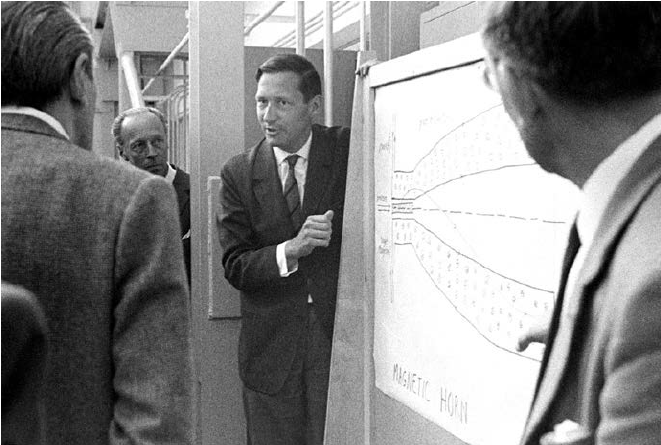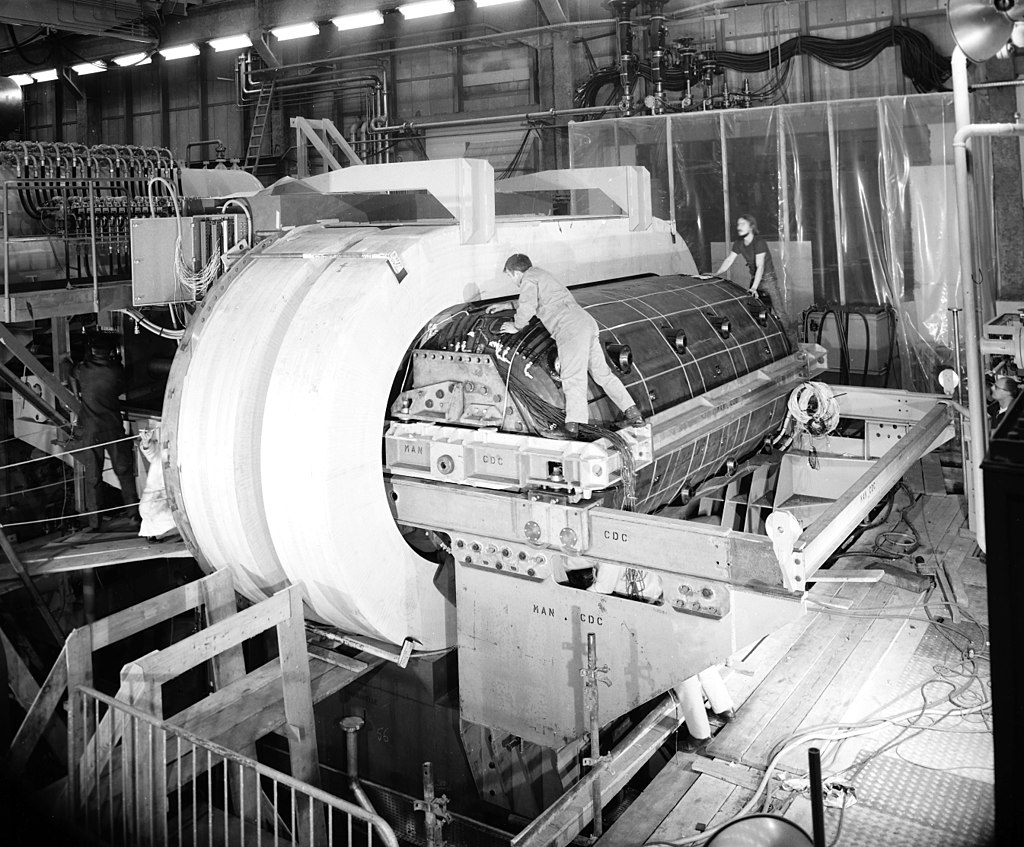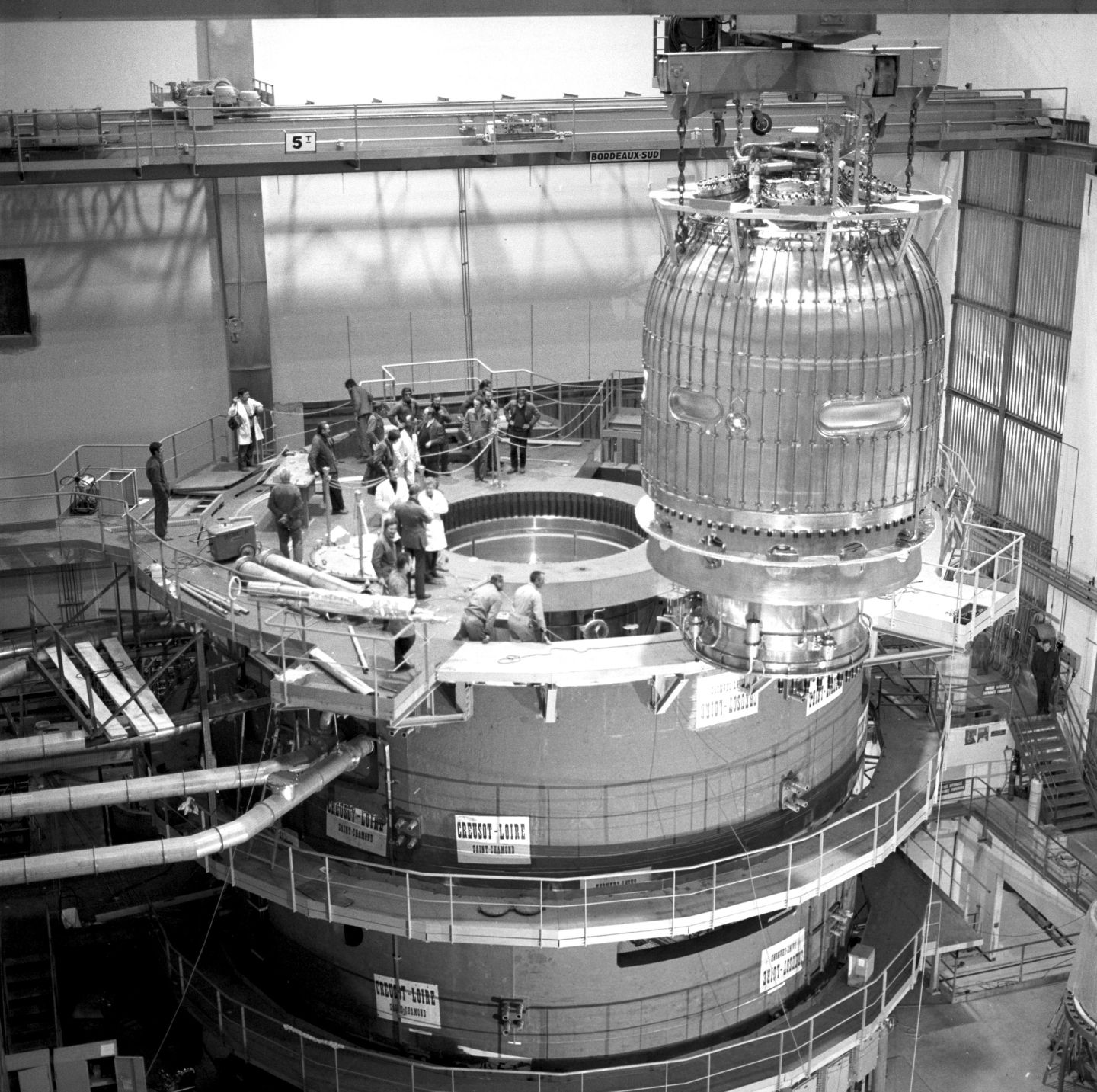Neutrino beams
 From 1959, the proton synchrotrons built in Brookhaven and CERN were able to accelerate protons to ~ 30 GeV. These high energy protons bombarded beryllium targets, producing pions and kaons which subsequently decayed into neutrinos. The first neutrino beams such as the one which allowed discovering the muon-neutrino in 1962 [Dan62] were considerably improved.The idea of Simon van der Meer to develop the “magnetic horn” has been crucial: a focusing device would collect the secondary pions and kaons from the target and would direct them toward the downstream experiments via a vacuum tunnel where they decayed, thereby increasing significantly the neutrino flux [Mee61].
From 1959, the proton synchrotrons built in Brookhaven and CERN were able to accelerate protons to ~ 30 GeV. These high energy protons bombarded beryllium targets, producing pions and kaons which subsequently decayed into neutrinos. The first neutrino beams such as the one which allowed discovering the muon-neutrino in 1962 [Dan62] were considerably improved.The idea of Simon van der Meer to develop the “magnetic horn” has been crucial: a focusing device would collect the secondary pions and kaons from the target and would direct them toward the downstream experiments via a vacuum tunnel where they decayed, thereby increasing significantly the neutrino flux [Mee61].
From the 60’s, neutrino beams at accelerators have served as laboratories for greater understanding of the neutrino itself, but also have harnessed the neutrino as a probe to better understand the weak nuclear force and the existence of strongly bound quarks inside the proton and neutron [Kop07]. The first great achievement of neutrino beams has been the discovery of neutral currents.
Neutral currents (1965-1978)
 At the end of the 60’s, Glashow, Weinberg and Salam developed the unified electroweak theory, which proposed the intermediate vector bosons W to propagate the weak interaction as well as a new interaction of neutrinos, charged leptons and quarks, the “neutral current” (Z exchange process). The observation of neutral currents then became critical to validate the theory. The heavy liquid bubble chamber Gargamelle, built under the direction of André Lagarrigue, had been designed to do neutrino physics. Using the new CERN neutrino beam, Gargamelle was the first to observe neutral currents, in July 1973, observation described in two papers, one dealing with leptonic neutral current [Has73a], the other with hadronic neutral current [Has73b]. This has been a convincing demonstration of the electroweak theory (which gives a common origin to the electromagnetic and weak interactions), soon confirmed by experiments at Fermilab [Ben74].
At the end of the 60’s, Glashow, Weinberg and Salam developed the unified electroweak theory, which proposed the intermediate vector bosons W to propagate the weak interaction as well as a new interaction of neutrinos, charged leptons and quarks, the “neutral current” (Z exchange process). The observation of neutral currents then became critical to validate the theory. The heavy liquid bubble chamber Gargamelle, built under the direction of André Lagarrigue, had been designed to do neutrino physics. Using the new CERN neutrino beam, Gargamelle was the first to observe neutral currents, in July 1973, observation described in two papers, one dealing with leptonic neutral current [Has73a], the other with hadronic neutral current [Has73b]. This has been a convincing demonstration of the electroweak theory (which gives a common origin to the electromagnetic and weak interactions), soon confirmed by experiments at Fermilab [Ben74].
Deep inelastic scattering experiments (1975-…)
 In the mid 70’s the SPS at CERN and the Tevatron at Fermilab permitted neutrino and antineutrino beams of energies up to 250 GeV and very high intensities. They were associated to big detectors, 1000 tons of electronic detectors or big bubble chambers, yielding thousands of events instead of a handful. The physics was very rich: precise checks of the quark-parton model, checks of the electroweak model and determination of the parameter sin2θw, determination of the quark structure functions (sea and valence quarks), tests of quantum chromodynamics (in particular measuring the scaling violations), study of the hadronization process,… The main detectors were CDHS and CHARM at CERN, HPWF and CCFR at Fermilab. Bubble chamber detectors (BEBC at CERN, 15-foot at Fermilab) were less massive (only ~20 tons) but allowed to study neutrino interactions on hydrogen or deuterium, i.e. directly on protons and neutrons.
In the mid 70’s the SPS at CERN and the Tevatron at Fermilab permitted neutrino and antineutrino beams of energies up to 250 GeV and very high intensities. They were associated to big detectors, 1000 tons of electronic detectors or big bubble chambers, yielding thousands of events instead of a handful. The physics was very rich: precise checks of the quark-parton model, checks of the electroweak model and determination of the parameter sin2θw, determination of the quark structure functions (sea and valence quarks), tests of quantum chromodynamics (in particular measuring the scaling violations), study of the hadronization process,… The main detectors were CDHS and CHARM at CERN, HPWF and CCFR at Fermilab. Bubble chamber detectors (BEBC at CERN, 15-foot at Fermilab) were less massive (only ~20 tons) but allowed to study neutrino interactions on hydrogen or deuterium, i.e. directly on protons and neutrons.
The role of neutrino in determining the nucleon structure functions is reviewed in [Die86].
Further information
The online Symmetry Magazine published in August 2009 an article on weak neutral current.
During the conference on the History of the Neutrino (Sept. 5-7, 2018 in Paris) :
- Sacha Kopp (State University of New York at Stony Brook, USA) related the construction of the first accelerator neutrino beams : here the slides and the video of his talk.
- Dieter Haidt (DESY Hamburg, Germany) told us the neutral current saga : here the slides , the video of his talk and his contribution to the Proceedings.
- Konrad Kleinkecht (Univ. of Mainz/LMU Muenchen, Germany) explained neutrino physics with these beams in the period 1971 to 1992 : here the slides , the video of his talk and his contribution to the Proceedings.
- Gary Feldman (Harvard University, USA) enlarged the field with long-baseline experiments. : here the slides , the video of his talk and his contribution to the Proceedings.
- and François Vannucci (LPNHE, France) presented a poster on the JURA neutrino experiment with a written contribution to the Proceedings.
References
| Author(s) | Title | Reference | Key-words | |
|---|---|---|---|---|
| Ben74 | A. Benvenuti et al. | Observation of Muonless Neutrino-induced Inelastic Interactions | Phys. Rev. Lett. 32 (1974) 800 | accelerator neutralc accelbib |
| Dan62 | G. Danby, J.M. Gaillard, K. Goulianos, L.M. Lederman, N. Mistry, M. Schwartz and J. Steinberger | Observation of high energy neutrino reactions and the existence of two kinds of neutrinos | Phys. Rev. Lett. 9 (1962) 36 - Reprint in “Neutrino Physics”, ed. by K. Winter, Cambridge University Press, 1991 | historical numbernu milestonebib overviewbib numubib accelbib plotbib detectorbib |
| Die86 | M. Diemoz, F. Ferroni and E. Longo | Nucleon structure functions from neutrino scattering | Physics Reports 130 (1986) 293 | review physrep accelerator accelbib |
| Has73a | F.J. Hasert et al. | Search for elastic muon-neutrino electron scattering | Phys. Lett. B46 (1973) 121 – Received Jul. 2, 1973 | historical accelerator neutralc milestonebib overviewbib accelbib plotbib detectorbib |
| Has73b | F.J. Hasert et al. | Observation of neutrino-like interactions without muon or electron in the Gargamelle neutrino experiment | Phys. Lett. B46 (1973) 138 – Received July 23, 1973 | historical accelerator neutralc milestonebib overviewbib accelbib plotbib detectorbib |
| Kop07 | Sacha E. Kopp | Accelerator neutrino beams | Physics Reports 439 (2007) 101 | review physrep accelerator accelbib |
| Mee61 | S. Van der Meer | A directive device for charged particles and its use in an enhanced neutrino beam | CERN-61-07, 1961 - First idea on the magnetic horn for designing neutrino beams | historical accelerator accelbib |
